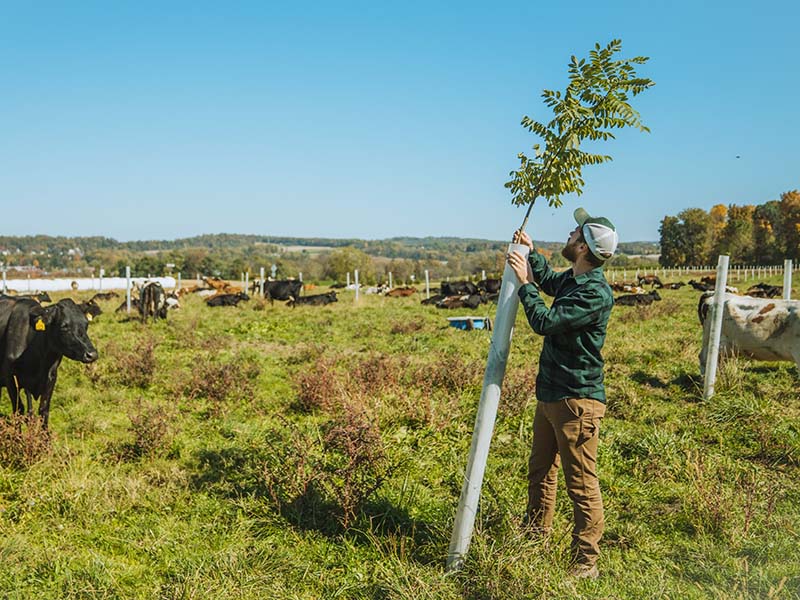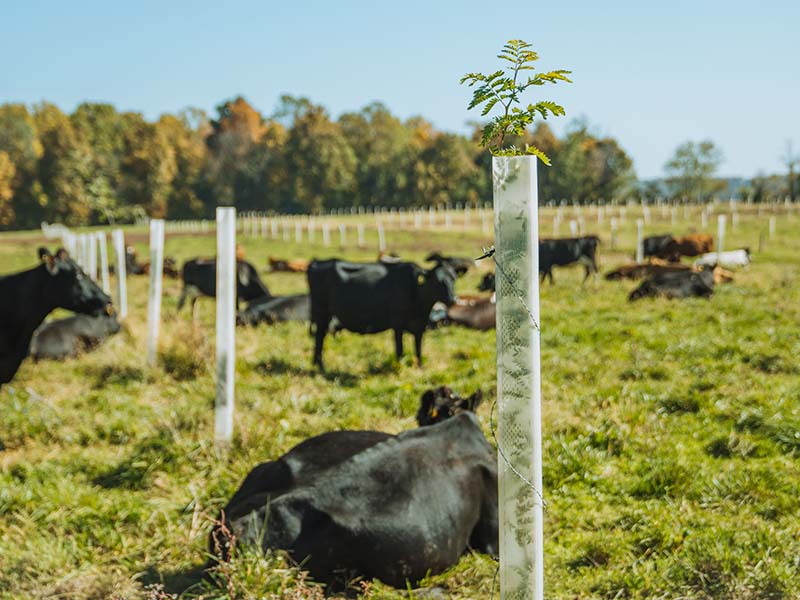 Austin Unruh checking on trees planted at Springwood Dairy.
Austin Unruh checking on trees planted at Springwood Dairy.
A stand of trees with contented animals grazing beneath them - it's the kind of bucolic scene usually reserved for picture books. Yet the practice of silvopasture has the potential to not only look good but also be good.
For Austin Unruh, planting trees in paddocks - a practice known as silvopasture - came about almost by accident. He was working in a conservation business that planted trees along waterways to improve water quality. Some of this work was on dairy farms, where owners dreamed of broader plantations, which could reduce heat stress in herds and improve their productivity. Seeing a gap, Austin switched his focus from planting trees purely for conservation to planting trees to support agricultural systems.
For silvopasture to work in practice, Austin needed to find a way to keep the land in production while the trees were establishing.
But for silvopasture to work in practice, Austin needed to find a way to keep the land in production while the trees were establishing. Working out a cost-effective way to do this would be key to seeing successful uptake.'We started brainstorming and trialling different methods,' Austin says.
While the initial driver for trees in paddocks was shade, once the trees were planted, other benefits soon became apparent. These included conservation aspects; structural diversity (i.e., having a range of different landscapes) meant that silvopasture farms could provide habitats for a greater range of species, such as birds, insects and bats.
The deal maker for many farmers was the ability to provide an additional feed source, often at times when it was needed.
However, the deal maker for many farmers to get on board with silvopasture was the ability to provide an additional feed source, often at times when it was most needed. This boon balanced the challenges of establishment costs and the need to protect young trees from grazing livestock.
Silvopasture can include a range of tree and forage varieties, and Austin says any climate that can naturally support forages and trees is suitable for silvopasture. The trick is to find the best species to complement the climate, rainfall and soil types.
 Honey Locust trees planted at Springwood Dairy
Honey Locust trees planted at Springwood Dairy
For example, Austin is based in Pennsylvania, on the US's east coast, where the climate is temperate. Here, the trees used in silvopasture fall into two categories: those planted for their feed - thornless honey locust, persimmon, mulberry - and those planted for their ability to quickly provide shade - black locust, hybrid willow and hybrid poplar.
But in areas further north, where persimmon and honey locusts don't thrive, Austin would opt for apple and pear trees for feed. Alternatively, in the arid midwest, he'd recommend thornless mesquite or other trees that can survive the harsh, dry periods once established.
Despite the benefits, silvopasture adoption across US grazing systems is low, but Austin is working hard to change this. His business, Trees For Graziers, has planted trees on 45 farms over the past four years, mostly within a one-hour radius, and has grown from Austin working alone to having eight full-time staff.
In that time, Austin has also seen improvements in the quality of the trees he sources and has learnt better ways of protecting them from being grazed upon while they're still young.
'The main limiting factor we've found is that farmers generally have too little time and money.'
While Austin and others like him continue to refine silvopasture practices, the biggest challenge to silvopasture expansion is finances. Because trees will take a few years to establish, farmers must wait before seeing a return on their investment, which can be challenging for cash flow. 'The main limiting factor we've found is that farmers generally have too little time and money to make such delayed investments, so planting trees doesn't happen,' Austin says.
Cost depends on a number of factors, but most silvopasture plantations that Austin has established use between 75 and 150 trees per hectare. This works out to about USD60 per tree, including the cost of the tree, labour for planting and several years of maintenance, mulch and protection with electric fencing.
But Austin is dedicated to helping those who invest in silvopasture overcome this initial cost.
'We are always looking for financial assistance for our clients, whether from government or non-profit groups, to reduce the cost of tree establishment,' he says. 'That said, this can certainly be done out of pocket - it just requires creativity to bring costs down and patience, knowing that it will be a while until you see the benefits.'
'There is no reason why silvopasture could not happen, and at a larger scale, in Australia.'
While it's in its infancy in the US, Austin believes there is no reason why silvopasture couldn't work in Australia. In fact, it may even be more successful here. 'Cattle farms tend to be much larger in Australia than in the eastern US, where our average client has 15-80 hectares and few bigger than that,' he says. Larger scale properties in Australia would be more cost-effective, while the longer growing seasons should see trees grow faster. But that optimism comes with a caveat.
'Silvopasture obviously only works in areas that can support trees, and the trees would be very different whether we are looking at a tropical savanna, subtropical or temperate regions with significant differences in rainfall and temperature patterns to adhere to. So each system needs to be locally adapted,' Austin says.
Despite the challenges, the message of silvopasture and its benefits keep the enthusiasm levels high for what he says is a win-win for farmers. 'Our whole goal with silvopasture is to boost farm productivity and profitability,' he says.
'Simply by adding shade, livestock will perform better, gain weight faster and produce more milk. And by establishing trees that drop high-quality feed or offer drought-proof leaf fodder, you can cut feed bills and increase stocking densities over time. It's a win-win - it just requires a bit of patience.'



